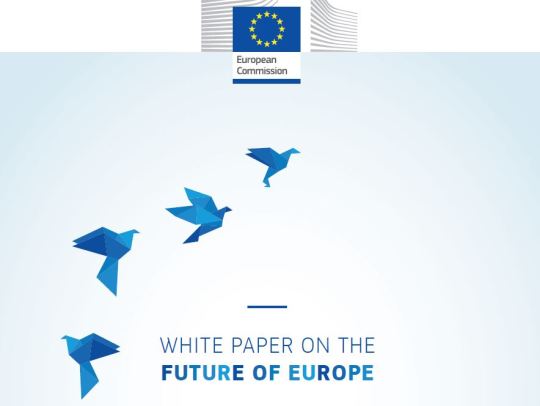Ahead of the 60th anniversary of the signing of the Treaty of Rome, the European Commission issued a White Paper on the future of Europe. Subtitled as “Reflections and scenarios for the EU27 by 2025″, the document draws up integration alternatives for the now effectively 27 member organization.

White papers of the Commission contain proposals for EU action in a specific area. The aim of this particular white paper is to present possible responses of Europe to challenges ahead taking into account foreboded changes in all major factors like security, world economy, world politics, population and climate change.
“Europe’s challenges show no sign of abating. Our
economy is recovering from the global financial crisis
but this is still not felt evenly enough. Parts of our
neighbourhood are destabilised, resulting in the largest
refugee crisis since the Second World War. Terrorist
attacks have struck at the heart of our cities. New
global powers are emerging as old ones face new
realities. And last year, one of our Member States
voted to leave the Union.”
One of the major changes that must be taken into consideration is sort of a consequence of all the others causing hardships to the EU, is the decrease of trust of EU citizens in EU institutions. The most articulate expression of this was of course what we now call Brexit and the threat of other member states following course, but there are other signs of distrust as well.
The paper provides five scenarios for the level of integration given that the present EU27 continue moving forward as a Union. The scenarios are not fully developed outcomes, and the future will probably not look like one or the other exclusively. It is more like a palette from which the member states can choose the colours to paint their futures together.
- Scenario 1: Carrying on
This scenario means the least change from where the EU is
currently, since it basically operates with carrying on with the current goals.
„The EU27
continues to focus on jobs, growth and investment by strengthening the single
market and by stepping up investment in digital, transport and energy
infrastructure.”
- Scenario 2:
Nothing but the single market
This
scenario is supported by the idea that member states will be unable to agree on
many key policy areas, so these areas will be left for bilateral agreements,
while the EU will focus on the single market.
„The functioning of the single market becomes
the main “raison d’être” of the EU27. Further progress depends on the capacity
to agree related policies and standards. This proves easier for the free
movement of capital and of goods, which continues tariff-free, than it does in
other areas.”
- Scenario 3:
Those who want more do more
The EU
continues as today. The deeper levels of integration are not baffled by the
lack of full agreement, they can be reached by the willing member states on a
partial basis.
„As a result, new groups of Member States
agree on specific legal and budgetary arrangements to deepen their cooperation
in chosen domains. As was done for the Schengen area or the euro, this can
build on the shared EU27 framework and requires a clarification of rights and
responsibilities. The status of other Member States is preserved, and they
retain the possibility to join those doing more over time.”
- Scenario 4:
Doing less more efficiently
The EU will
focus on certain areas to strenghten, and reduces or ceases cooperation on
other areas deemed less important by member states.
“The EU27 steps up its work in fields such asinnovation, trade, security, migration, the management of borders and defence. It develops new rules and enforcement tools to deepen the single market in key new areas. It focuses on excellence in R&D and invests in new EU-wide projects to support decarbonisation and digitisation.”
- Scenario 5: Doing much more together
The way things stand currently, this is perhaps the least likely scenario, where EU member states share more power than ever before.
“Cooperation between all Member States goes further than ever before in all domains. Similarly, the euro area is strengthened with the clear understanding that whatever is beneficial for countries sharing the common currency is also beneficial for all. Decisions are agreed faster at European level and are rapidly enforced.”
Besides this White Paper, the European Commission plans to issue reflection papers on other topics in the course of 2017 with the aim of generating debate and working towards a solution in the most pressing questions regarding the future of Europe by the time of the 2019 European Parliament elections.
The EU is not a simple institution to understand as it is. Besides, European states are traditionally nation states, highly sensitive about their souvereignty. The spreading of nationalistic sentiments nowadays kind of works against any further integration of the EU. Whether this can still be turned around remains to be seen.

